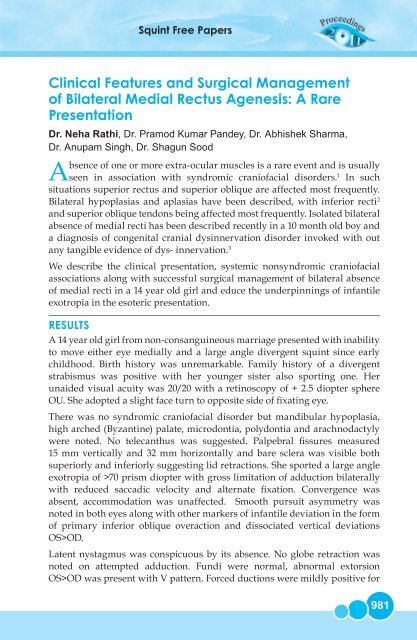Squint Free Papers - aioseducation
Squint Free Papers - aioseducation
Squint Free Papers - aioseducation
You also want an ePaper? Increase the reach of your titles
YUMPU automatically turns print PDFs into web optimized ePapers that Google loves.
<strong>Squint</strong> <strong>Free</strong> <strong>Papers</strong><br />
Clinical Features and Surgical Management<br />
of Bilateral Medial Rectus Agenesis: A Rare<br />
Presentation<br />
Dr. Neha Rathi, Dr. Pramod Kumar Pandey, Dr. Abhishek Sharma,<br />
Dr. Anupam Singh, Dr. Shagun Sood<br />
Absence of one or more extra-ocular muscles is a rare event and is usually<br />
seen in association with syndromic craniofacial disorders. 1 In such<br />
situations superior rectus and superior oblique are affected most frequently.<br />
Bilateral hypoplasias and aplasias have been described, with inferior recti2 and superior oblique tendons being affected most frequently. Isolated bilateral<br />
absence of medial recti has been described recently in a 10 month old boy and<br />
a diagnosis of congenital cranial dysinnervation disorder invoked with out<br />
any tangible evidence of dys- innervation. 3<br />
We describe the clinical presentation, systemic nonsyndromic craniofacial<br />
associations along with successful surgical management of bilateral absence<br />
of medial recti in a 14 year old girl and educe the underpinnings of infantile<br />
exotropia in the esoteric presentation.<br />
RESULTS<br />
A 14 year old girl from non-consanguineous marriage presented with inability<br />
to move either eye medially and a large angle divergent squint since early<br />
childhood. Birth history was unremarkable. Family history of a divergent<br />
strabismus was positive with her younger sister also sporting one. Her<br />
unaided visual acuity was 20/20 with a retinoscopy of + 2.5 diopter sphere<br />
OU. She adopted a slight face turn to opposite side of fixating eye.<br />
There was no syndromic craniofacial disorder but mandibular hypoplasia,<br />
high arched (Byzantine) palate, microdontia, polydontia and arachnodactyly<br />
were noted. No telecanthus was suggested. Palpebral fissures measured<br />
15 mm vertically and 32 mm horizontally and bare sclera was visible both<br />
superiorly and inferiorly suggesting lid retractions. She sported a large angle<br />
exotropia of >70 prism diopter with gross limitation of adduction bilaterally<br />
with reduced saccadic velocity and alternate fixation. Convergence was<br />
absent, accommodation was unaffected. Smooth pursuit asymmetry was<br />
noted in both eyes along with other markers of infantile deviation in the form<br />
of primary inferior oblique overaction and dissociated vertical deviations<br />
OS>OD.<br />
Latent nystagmus was conspicuous by its absence. No globe retraction was<br />
noted on attempted adduction. Fundi were normal, abnormal extorsion<br />
OS>OD was present with V pattern. Forced ductions were mildly positive for<br />
981

















